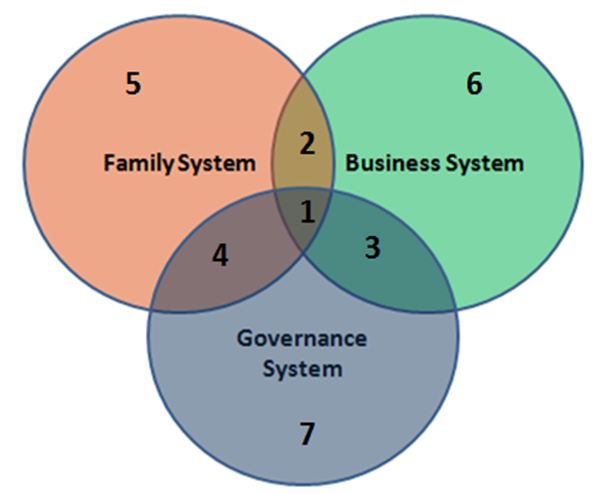A family business is defined in terms of three systems: the company itself, the family attached to it, and the owners. Understanding how these three systems work in your family business and maintaining a “healthy balance” can play an important role in ensuring long-term sustainability of your family business.
- The Business System includes the organization’s mission and strategies and the infrastructure that helps the organization achieve its goals.
- The Family System involves family members connected with the business, with consideration of the family’s goals and aspirations, its roles and relationships, communication patterns and cultural values.
- The Ownership or Governance System includes the business’ legal formation and form of ownership, the board of directors, and the goals and aspirations of those who own and govern the business.
These three systems are fluid, and while each system includes the word “goals,” the goals of each system may actually be very far apart. For example, a goal in the family system may be the development and support of family members, while a goal in the business system might be profits, revenues, efficiency and growth. These two goals might work against one another. Each family business is unique and may require the help of family business advisors to help sort through the difficult family, business and governance issues. Often, a third-party point of view with its objective guidance is helpful in assessing and understanding the relationship a family has with its business.
Due to the interdependence of the three systems, the three circles overlap. For example, at the intersection of the three circles (zone 1 in photo), you find people who are equally members of the family, company employees, and company shareholders. At the intersection of family business (zone 2 in photo), you find people who are family members and employees of the company at the same time, but do not own shares of the company. Continuing in this vein, seven zones can be distinguished for each person linked to the family business.
The advantage of placing each person within the circles is to better understand their behavior, which is often linked to the advantages and disadvantages of their position. For example, the founder of the company is usually found in zone 1. This person generally has a good understanding of the family as well as the strengths and weaknesses of each family member. The person also knows the company inside and out, and is in a perfect position to help the family fully benefit from the company and vice versa.
This is also the person who is responsible for arbitrating conflicts between the family, the company, and the owners. Exercising the power that goes with this position should not be confused with the roles of head of the family, head of the company, and owner. In addition, the person should not try to solve family conflicts by using the company, or use the family to solve company conflicts. Being in zone 1 is clearly not standing on the sidelines!
The issues are different for the people in zone 4. These family members own shares in the company but do not work in it. There is a strong possibility that they are more interested in the dividends they can receive in the short term than they are in the long-term performance of the company. By becoming aware of the interests of the people in zone 4, the owner/manager will be in a better position to make the right decisions.
Ask yourself, what zone are you in? Where will you be in two years? In five years? Will you move from zone 2 to zone 1? Your point of view on your contribution to the company, the company’s future and what it can bring you will surely change with this move. Think about the members of your family. Where are they situated? What are their expectations of the business? What is your reaction to these expectations? Are they justified? Can you respond to them? What can you do about them? Talking about them is probably a good place to start.
Family business consultants work at the boundaries where there are overlaps among the three family business systems. Choosing a qualified team of family business advisors with various multidisciplinary backgrounds can oftentimes provide an objective third-party approach to helping the family, the business and its owners achieve their collective goals.
Click here to learn more about Curchin’s Family Business Advisory Practice.


